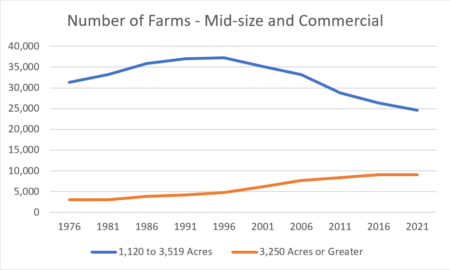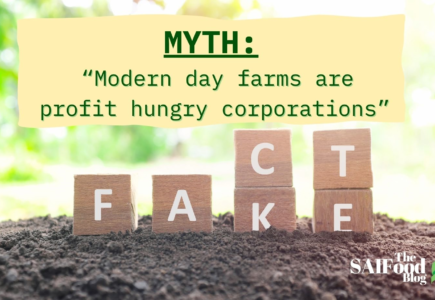Agriculture Myth Busting
The Modern Farm
If the 2003 Canadian documentary
“The Corporation” is to be believed, an incorporated company is a self-serving agent with tendencies akin to that of a sociopath. Following early economic theory this is a logical statement, as a corporation is a standalone entity with little regard for others and a single goal: profit maximization.It may come as a concerning surprise that
25% of Saskatchewan farms were incorporated as of 2017, the second highest rate in Canada. Media outlets detailing the shift from family farms to corporate farms often raise further alarm, making claims that large corporate entities are
overrunning the family farm, consolidating land, ruining natural habitats, and growing food with no regard for the environment. However, those in tune with the agricultural industry understand this narrative to be one of the most aggravating myths surrounding primary agricultural production in the modern day.

A Harmful Fallacy
This narrative is damaging to the agriculture industry, where
advancements in machinery, genetics, and technology are driving consolidation and the growth of farm size. As labour becomes scarcer and equipment size increases,
economies of scale have taken hold of primary agricultural production in most developed economies. However, the sentiment has arisen in recent years that farms are “mining the land” and that “corporate boardrooms decide who gets to eat, what they eat, and how they receive that food”. This narrative is intended to displace consumers from their positive views of modern agriculture by demonizing farms as large corporations and farmers as their CEOs; both corporations and their CEOs often come under severe scrutiny and
bend over backwards to appeal to a woke agenda. Agriculture must be held to a high standard in terms of food security and environmental welfare; however, if food security is to be maintained any calls for change to farm production must come from a scientific background and not an Environmental Social Governance agenda. It’s important to assess the impacts of agriculture using evidence-based methods, not precaution-based methods, that all to often lack robust assessment criteria. Serious harm can arise from the falsehood that modern day agriculture resembles the modern-day corporation.Further dispersion of this myth could be extremely damaging to the development of the agriculture industry. Narratives that demonize farmers may sway public opinion, one of the strongest metrics in a modern-day society. Public opinion drives policy much more than purchase decisions, as politicians often mirror public opinion to ensure their popularity remains high. Currently, Canadians place a high level of trust in farmers [1]; dispelling myths such as this one can ensure trust remains high moving forward to ensure the prosperity of Canadian agriculture in the decades to come.
Growth Drivers
As technological development enables the further growth of farms, margins grow and competition for additional acres compounds, substantially increasing land prices. As a result, the average
commercial grain and oilseed farm in Saskatchewan operates on nearly
7,200 acres. This is a stark contrast from the average Canadian farm size of
1,766 acres, and a momentous increase from the average size of
845 acres in 1971. It is argued that dispersion between large farms and their smaller counterparts is growing, with no sign that a trend reversal is coming. Between 1976 and 2021, the
number of farms in Canada decreased by over 150,000 farms, with the quantity of farm under 1,120 acres mirroring this decline, as illustrated below.
 Thousands of Saskatchewan farms
Thousands of Saskatchewan farms operate on 640 acres (one section) or less, hence the spread between the size of the average farm and the average commercial farm, where commercial farms are defined as those over 3,520 acres. The growth in land values have made many farmers’ balance sheets extremely strong however, this was not achieved without great
risk and substantial investments, and continues today in a volatile industry. The result has been a
three-fold increase in farms over 3,250 acres and a decrease in mid-size farms between 1976 and 2021, as demonstrated below.

It appears that Saskatchewan farmers are driven by increased economic performance. However, this raises many important questions that must be addressed to dissolve the myth at hand. Namely, who are the faces, names, and personalities at the helm of incorporated farms? How have they grown to the size they are today? What implications does this have for the economic and environmental welfare of primary food production in Canada?
The Family Farm
White picket fences, large red barns, chicken coops, milk cows, a half-section of cropland, a handful of beef cows and horses, and enough hay land to sustain the animals is what may come to mind when those unfamiliar with agriculture hear the term ‘family farm’. Gone are the days where such diversification and small scale was commonplace in agriculture, despite a
few examples remaining across Canada. In 2023, many family farms are incorporated, with
22% of Canadian farms classified as family corporations. Compare this to a mere
3.21% organized as non-family corporations and a whopping
51.68% arranged as sole proprietorships. Additionally, foreign investment in agricultural land in Saskatchewan is limited to
10 acres, the equivalent of about 7.5 football fields. This creates major barriers to entry for exorbitantly wealthy foreign entities attempting to monopolize farmland in Saskatchewan and neighboring provinces with similar regulations. The result is that virtually all Saskatchewan farm land is owned by Saskatchewan residents and farmers.In the modern day, family farms in Saskatchewan are growing rapidly with family farms being passed down through multiple generations. Farmers are operating on the same land their ancestors homesteaded in some instances, and they are doing so with utmost care for the environment while pushing the development frontier forward through growth and newfound efficiency. In fact, a 2002 study found that Saskatchewan farmers are searching for practices that
exceed the environmental benefits of government recommended best management practices [2]. Today, a suite of
cost-sharing systems, stewardship programs, and producer education initiatives ensure Saskatchewan farmers and ranchers uphold the environmental sustainability of our sector. Additionally, the rapid adoption of no-till production has enabled the grain and oilseed sector to sequester large amounts of carbon [3]. This highlights the steps farmers in Saskatchewan are taking to pursue profit and expansion while maintaining healthy productive soils for their children and grandchildren.
Advantages of Incorporation
Farming is an occupation characterised by long hours, year-round work, and
high risk across many dimensions. Focusing on the latter, risk in agriculture is commonly perceived as weather, policy, or market uncertainties, especially from an economic standpoint. These are all relevant risk sources, and explain the
highly variable returns to agriculture. Beyond economic factors, a more important risk dimension threatens human capital on the farm. Agriculture is a high-risk endeavour, topping the national list as the
riskiest occupation in Canada in terms of workplace fatalities.One method to minimize the risks faced in agriculture while maximizing economic upside is to incorporate the farm. By doing so, agricultural producers are hedging against financial risk by
minimizing income tax payments in profitable years to build a nest egg for when conditions inevitably turn. These tax savings arise because of the significant difference in
corporate and personal income taxes, allowing farmers to retain significant amounts of money for savings or reinvestment into the farm. Additionally, corporations have no lifespan and, if properly structured, will remain operational in the event its president is no longer capable of running an agricultural operation. On the contrary, sole proprietorships would be stuck in limbo until a legal division of assets occurs. This makes incorporation highly advantageous in an industry as dangerous as agriculture. Considering the importance of multigenerational transition in farming, incorporating the farm allows for an easier transition of assets between generations.
Concluding Remarks
Dispelling the myth that farmers are the CEOs of industrialized agricultural enterprises that are pushing out the remnants of the family farm is an important myth to refute with evidence. Two factors have driven the consolidation and incorporation of Canadian farms in the modern day, and both have improved the prosperity of farmers while lessening the costs of food production. The myriad of benefits associated with incorporation, including tax advantages, ease of farm transition, and improved security regarding the legacy of the family farm, have incentivized farmers to incorporate their operations. Simultaneously, rapid advancements in technology and increased farm specialization have improved farm efficiency and margins to enable the most efficient farms to grow and prosper. Many of our farms are growing into large incorporations, and this shift represents a positive development that should be celebrated, not marred.
Additional Resources
[1] C. Sutherland, C. Sim, S. Gleim, and S. J. Smyth, “Consumer insights on Canada’s food safety and food risk assessment system,”
J Agric Food Res, vol. 2, pp. 1–9, 2020.[2] R. F. Kehrig, “AGRICULTURAL PRACTICES AND WATER QUALITY IN SASKATCHEWAN: THE SOCIAL ECOLOGY OF RESOURCE MANAGEMENT,” 2002.[3] C. Sutherland, S. Gleim, and S. J. Smyth, “Correlating genetically modified crops, glyphosate use, and increased carbon sequestration,”
Sustainability (Switzerland), vol. 13, no. 21, Nov. 2021, doi: 10.3390/su132111679.

 Thousands of Saskatchewan farms operate on 640 acres (one section) or less, hence the spread between the size of the average farm and the average commercial farm, where commercial farms are defined as those over 3,520 acres. The growth in land values have made many farmers’ balance sheets extremely strong however, this was not achieved without great risk and substantial investments, and continues today in a volatile industry. The result has been a three-fold increase in farms over 3,250 acres and a decrease in mid-size farms between 1976 and 2021, as demonstrated below.
Thousands of Saskatchewan farms operate on 640 acres (one section) or less, hence the spread between the size of the average farm and the average commercial farm, where commercial farms are defined as those over 3,520 acres. The growth in land values have made many farmers’ balance sheets extremely strong however, this was not achieved without great risk and substantial investments, and continues today in a volatile industry. The result has been a three-fold increase in farms over 3,250 acres and a decrease in mid-size farms between 1976 and 2021, as demonstrated below. It appears that Saskatchewan farmers are driven by increased economic performance. However, this raises many important questions that must be addressed to dissolve the myth at hand. Namely, who are the faces, names, and personalities at the helm of incorporated farms? How have they grown to the size they are today? What implications does this have for the economic and environmental welfare of primary food production in Canada?
It appears that Saskatchewan farmers are driven by increased economic performance. However, this raises many important questions that must be addressed to dissolve the myth at hand. Namely, who are the faces, names, and personalities at the helm of incorporated farms? How have they grown to the size they are today? What implications does this have for the economic and environmental welfare of primary food production in Canada? 

